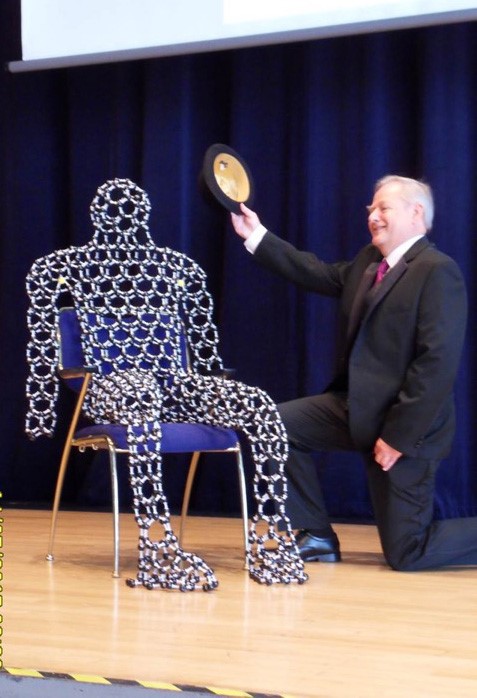21 Jan 2019
Professor Malcolm Heggie
 Malcolm dressed as his hero ‘Steed’ from The Avengers with ‘Molly’, his human-like creation, built entirely from hexagonal (graphitic) rings
Malcolm dressed as his hero ‘Steed’ from The Avengers with ‘Molly’, his human-like creation, built entirely from hexagonal (graphitic) rings
Malcolm Heggie, Professor of Chemistry at Loughborough, sadly passed away on 17 January 2019.
Malcolm graduated from the University of Exeter with an honours degree in Physics and Chemistry before completing a PhD in Theoretical Physics with Bob Jones at Exeter in 1982. He held various research positions in Physics and Computer Science at Exeter until 1996, when he accepted a lectureship in Chemistry at the University of Sussex; he was promoted to Professor of Theoretical Chemistry in 2004. In 2012, he left Sussex to take up a Chair in Chemistry at the University of Surrey, and in September 2016 he joined Loughborough University.
Malcolm’s research has bridged chemistry, physics, and applied mathematics. He worked on many different materials over his career but is best known for his contribution to the understanding of graphite, for which he was presented with a Special Recognition Award (2008) from the British Carbon Group for outstanding leadership.
In the short time he was at Loughborough, he helped negotiate an EDF-sponsored lectureship and was also successful with a joint EPSRC-NSF award to investigate how fissionable materials interact with graphite.
Malcolm gave outstanding and entertaining talks. He variously dressed as Steed from The Avengers, brought along homemade props, recreated the movement of carbon dislocations using his body, and sometimes sang to fill gaps while IT support fixed broken presentations. He was in demand as a plenary speaker at international meetings such as at the annual CARBON conference. He can be seen in action here with a popular web lecture for the Vega Science trust.
Malcolm’s theoretical work on defects and radiation damage in graphite is highly cited and in addition, he developed a ‘ruck and tuck’ model to explain the structural changes in graphite under irradiation.
Malcolm’s style of collaboration within his groups and with other scientists reflected his personality: warm, open and friendly. He married his long-term partner Sally in the summer of 2018, and he was a dedicated father to his daughter, Laura. At many summer conferences he was the first to get swimming in the sea, and he passed on this love of the beach to his grandchildren. Both Sally and Laura were with him when he died.
His research group at Loughborough will honour him by continuing to develop his ideas and producing the high standard research for which he was known.














